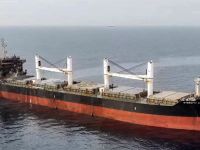Finding more elusive traps - both within mature fields and in frontier exploration - will not just be a matter of using better tools to recognize smaller and more subtle traps, but also of building on diverse clues to help unlock the unseen and understand the unexpected.
We need to guard against creating a generation of `Nintendo' explorations who have lost touch with real rocks.
We need to ensure that we allow our geoscientists to continue to cultivate and develop the fundamental skills for which their degrees trained them - and which brought them into our industry in the first place.
Strategic focus isn't just something that can be expressed geographically but is also reflected in the kind of exploration that a company concentrates on, which brings me to portfolio optimization. This is a conventional cross plot of risk on the vertical axis against reward on the horizontal axis.
The colors clearly express where you would ideally like most of your prospects to sit, i.e. in the upper right hand corner where the rewards are high and the risks low.
And indeed, the opening up of some of those basins I referred to earlier has allowed companies with the right access strategies - another key success factor - to populate this quadrant, hence the increases in success rates, volumes per well and finding costs we have seen in recent years.
I would argue, though, that the supply of such prospects is not unlimited, and a balanced prospect portfolio more typically comprises a range of different opportunities across the risk reward spectrum, shown by the ellipse.
The trick is to identify what can be done to move those prospects towards the NE quadrant, and avoid them slipping towards the SW.
It may seem obvious, but for those Frontier prospects that offer high rewards, the objective of the explorer has to be to do what he can to reduce the risks to an acceptable level. And different companies will have different views of what an acceptable level of risk is.
Another of the advantages of having a large portfolio is the ability to be increasingly selective about which prospects to drill.
It's about having choice. We should, though, not kid ourselves that exploration is ever going to be a zero-risk game.
There will always be risks; the skill lies in managing them effectively. So it's not just a question of having choices to make; it is also about making the right choices.
This graph show the relative pre-drill expectation volumes in yellow and the volumes actually discovered in green by a number of exploration wells drilled by Shell, plotted against the pre-drill probability of success class in which the prospects resided.
It shows that very little reward has been derived from high risk wells with a POS of less than 20 percent, where the volumes found have been less than half what was predicted, a feature that I know others who have conducted similar analysis have found.
There is, then, a risk level below which it is historically shown to be dangerous to venture.
Look, though, at the mode of the distribution, which clearly lies within the 20-40 percent probability of success class.
This clearly suggests that application of too rigorous a cut-off is likely to result in a significant erosion of discovery volumes.
It is important in this respect to distinguish the risks inherent to the prospect itself from those of the play within which the prospect resides.
Drilling well-defined traps in basins where you are not clear that you have all the other necessary elements of a successful petroleum system present is a very different thing from drilling in a basin that you know has got what it takes to produce world class hydrocarbon accumulations - like the example of the South Oman Salt Basin I talked of earlier.
Note, too, that this analysis says something interesting about wells which are considered to be `dead certs'.
This allegedly low risk is that within which what I call `designer wells' reside.
I define a `designer' well as the right well on the right prospect in the right play in the right basin at the right time for the right piece of existing infrastructure.
Here proper attention to balanced risk assessment is just as important if not more so, particularly when the volumes that are being targeted are on the margins of economic viability.
Often this kind of accumulation can only be developed economically if the exploration well is designed in such a way that it can be used later as either a producer or injector, so the costs of failure may be very high.
The big danger in this kind of exploration, which has historically led to a great deal of value erosion, has been the inability of companies to know when to stop - or at least to pause for breath.
The manager of a producing asset, faced with growing unit operating costs through declining production but with an undrilled prospect lying nearby, is unlikely to be philosophically inclined to make a proper assessment of the risks of drilling that prospect - even if he is technically equipped to do so.
It is for this reason that designer exploration perhaps more than anything requires the benefit of a high level portfolio overview, and an assurance that the risks have been appropriately assessed and that only the very best are selected.
On the other hand, this kind of well, if successful, can be extremely profitable. Even if the finding cost may be relatively high, the ability to take advantage of existing infrastructure to minimize the costs of development may enable much greater value to be created from a small satellite field than from a much larger structure that is more remotely situated.
Pushing the risk management envelope in this way is something that many companies have been successfully doing for many years in mature provinces such as the North Sea.
To ignore designer exploration in favor of elephant hunting alone makes it more difficult to demonstrate that a company is generating both long-term growth and short term value through its exploration programme.
Thus in Shell this year we are not only able to point to our fair share of volumetrically-material discoveries to underpin our growth aspirations, not least in the sizeable Kashagan discovery in Kazakhstan but also in the deepwater basins of the GoM, Brazil and Angola.
We can also point to several excellent examples of discoveries that will generate both short term production and value.
For example, the Soku North well, which was drilled in Nigeria recently and found some 100 million barrels of reserves was brought on stream within 80 days of spudding the exploration well.
Or Pohokura, in New Zealand, a 1 TCF gas discovery sitting directly beneath a Methanol plant.
Or Lumba-Lumba in Brunei that had already achieved payback by the end of the third quarter.
Or Kommerzijl in the Netherlands that will also be on stream before year end and helpfully proved up a downthrown fault seal play that opens up yet more potential for the future.
And even the modest Curlew D South well drilled here in the Central North Sea over the New Year, which also achieved very early payback, in this case by mid-year.
Of course, reducing costs, particularly drilling costs, plays a vital role in all of this, not only in terms of its impact on exploration finding costs, but also on the ultimate costs of development.
This graph shows the staggering reductions in well times that have been achieved by Shell Expro between 1998 and 1999 through the application of Shell's `Drilling the Limit' philosophy.
This not only helps to reduce the minimum volumes for economic development of smaller prospects, but also helps to reduce the risk threshold for frontier prospects.
If you can drill twice or three times as many wells for the same number of dollars, maybe you can test a few more of those high reward prospects where, despite your best efforts, the residual risks are still relatively high - Prospects that you might otherwise be discouraged from drilling for fear of exceeding your exploration expense targets.
The success of designer exploration is critically dependent on the degree to which explorations are able to work hand-in-glove with their discipline counterparts.
This needs to be done in such a way as to avoid the kind of disruptive hand-offs between exploration and production that have in the past lengthened the all important gap between discovery and first production.
This shows the kind of cycle time reduction that adopting such a multidisciplinary approach has had on Shell Expro's cycle times over recent years.
Reductions in the costs of developing small finds through the application of innovative sub sea technology will also have a marked impact upon the scope of `designer' exploration.
The colored contours on this map of the Central North Sea represent the minimum size of prospect that can be economically developed, which as you might expect increases as you move further away from a host facility.
Shell Expro have developed a GIS-based modeling tool than enables them to assess what the impact would be of cost reductions at any stage of the lifecycle.
This tool shows that a 50 percent reduction in sub-sea development costs would extend the maximum distance for development of a 5 million-barrel field from five to twenty five kilometers, and the maximum reach from 30 kms to 50 kms.
This would result in a three times increase in the volumes of oil and gas that could be economically developed.
Cost reductions of this type can only come about if the entire life-cycle has been addressed and catered for before the well is ever drilled, which cannot be achieved in explorations are working in a functional silo.
This need on the one hand for proximity of the explorationist to those who best understand the host asset whilst on the other maintaining the degree of detachment implied by optimal portfolio management and risk assessment is one of the more difficult tensions to manage in our business. This is where optimal deployment of human resources plays its part.
However much we may acknowledge the benefits of having a diverse work force - a difficult enough goal in itself - making sure that you have the right people at the right time in the right place to work on the right prospect is even more of a challenge.
Our industry is characterized by an age profile that is weighted heavily to the over 40s, and achievement of our collective growth targets is going to put an immense strain upon our human resources.
To achieve these goals we are going to need to introduce far more flexibility into our work flows to enable efficient deployment of skills whilst at the same time providing a compelling employment deal to attract and retain them.
I said I would conclude by talking about what I thought would be the real differentiators of best-in-class exploration in the years ahead, and to me this will be it; the ability to attract and retain the best brains in the business.
It is argued by some that technology is less important to our industry today.
That what really counts now is commercial drive and acumen, and that we can simply buy all the technology we need off the shelf.
I certainly agree that commercial capabilities are a necessary condition, but they are not sufficient.
Technology will continue to be central to our performance, future prospects and ability to contribute to society, and commercial success will depend more than ever on the skills, understanding and creativity of those who develop and apply our technology.
We need geoscientists today that are as comfortable talking about the fiscal environment as they are about the depositional environment.
When we talk about technology, we tend to talk about things - about pixels and portals, platforms and processes.
In reality, though, it is about people - attracting the best, developing their skills, extending their experience, creating an environment in which they can work effectively together, encouraging and harnessing their creativity, and valuing them and what they do.
It's also about giving back confidence to geoscientists, something which I sense has been eroded in recent years.
Keeping this vital group of smart people happy is not a trivial task, and I am not sure that I have all the answers, but I feel sure that those who gets the right choreography of knowledge preservation, people and technology will ultimately have the leading edge.
By Andy Wood, Head of Global Exploration, Shell International E&P B.V.
Source:Shell.com
© 2001 Mena Report (www.menareport.com)







